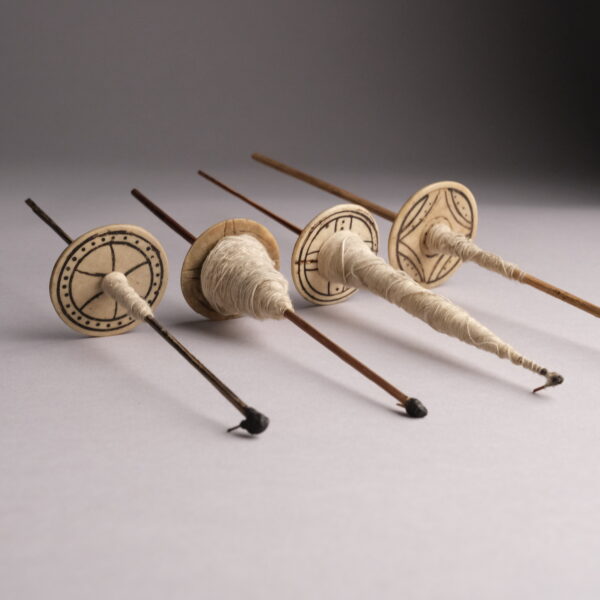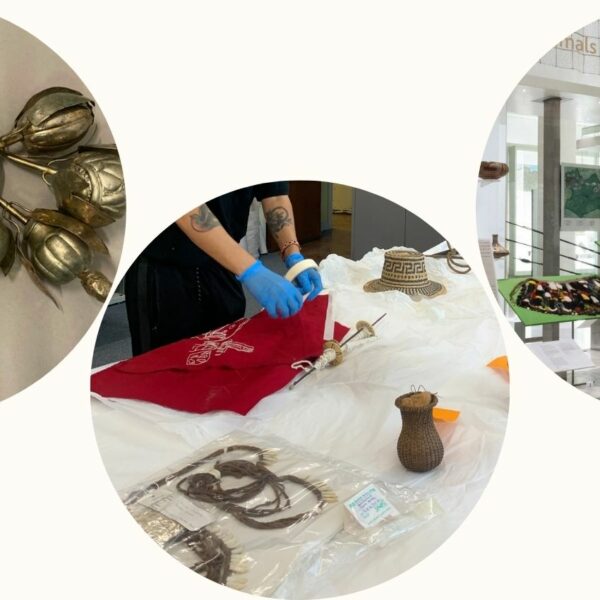‘About the Threads and Paths of our Wapichana Story’ by Roseane Cadete Wapichana
My stay at the British Museum and the encounter with our objects and the data catalogued in them revealed that Ashburner (1984) described us as a “tribe” of Amerindians living in the Rupununi River District. We Wapichanas are not a tribe, we are a people. Our History can’t be reduced to a label on objects that are stored in a box. Our History goes beyond labels.
When writing to the British Museum, Ashburner (1984) provided a reduced vocabulary that he tried to reproduce as phonetically as possible. He reported that he had observed the difference between nets made of cotton thread, one of which was more open, used for travelling, and the other more closely knit, to be used at home by the family. When he learnt from a missionary friend that the region inhabited exclusively by the Wapichana was being occupied by farms, he said: “I can’t think that the arrival of civilisation has really made them any happier”.
So I ask: “Were we so unhappy before colonisation?”
If my grandmothers, who were sisters, were so happy in their territory, why were they made to choose between one staying in Brazil and the other in British Guiana? Did they become happier upon being separated by a Border to meet again 50 years later to say goodbye before returning home? Or was it the Earth that was prettier and happier with farms and cattle while the sisters’ tears were shed?
This was just one of the many examples of violence suffered by my people.
The State, the Museum and Schools are but a few of the many who have violated our culture. They were mainly responsible for the borders in our languages, our memory and our territories.
I would like to clarify that it’s not an explorer defining the threads of this story today, but we ourselves, we who were born and raised in this region, we the Wapichana. Our roots are extensive, like the caimbé tree that withstands the summer fires of the lavrados savannas.
During our visit to the Pitt Rivers Museum, we found documents dating from 1907, and we wondered: Why have we only been invited now? Why a century later? We’ve been waiting for this reunion for so long. But they preferred to keep the spirits of our grandmothers and grandfathers in boxes. Kept for whom? For what reason?
As I entered the Pitt Rivers Museum, I heard Grandma’s voice, and through her spirituality, she said that the river’s whirlpool took a long time to find the sea, and I crossed over to meet her in a room surrounded by other Wapichana essences, smelling the strong resin smoke exhaling the harsh marks of colonisation that I grew up hearing about and experiencing, the harsh marks of the ban on using our language, our dance in thanksgiving to the sun, the moon, nature and the creator of all these things – all because the church told us it was a sin. Feeling the harsh marks of territorial disputes, the echoing voice of the many times my grandparents were held at gunpoint by the colonisers in order to keep our lands demarcated and guarantee our resistance to continue our existence. To be able to encounter the network of threads and feel the thread of the flute, the breath of the flaps, the sound of the maraca, the whirring of the spindles, is to feel that our memory yearns for travelling along healing paths. These were the downfalls of our history.
It was like a meeting of grandchildren and grandparents that lit the maruai resin and blessed us, strengthening us to echo beyond the borders that divided our people. It is the speech of threads.
No, it’s not about historical or social reparations. What would this solve? Just to connect the Canauanim threads to those of the British Museum? And the return on all this? What will we have? A return for whom? It’s about strengthening those strands. It’s about bringing in more relatives to teach you how to strengthen the threads, how to make strong, resistant threads. Bring prayers and songs. Smoking.
If, for instance, the school and the museum represent aspects of a colonising project, why not strengthen the threads with these institutions in aid of the healing paths of museums and communities?
Currently, there are more than 300 peoples with more than 180 languages in Brazil, making it one of the most diverse linguistic areas in the world. This must somehow be part of our training as human beings, so that we may understand that our ancestral memories are part of this humanity. We represent oral narratives or living testimonies of the creation of collective memory. We are looking for articulations and historical debates that allow us to perceive a meeting of a plural discourse. It’s not just the Wapichana people, but all the native peoples whose memories this museum harbours. Museums aren’t going to solve all this cultural violence against our peoples, but we can think of them as one of the instruments for connecting community life with this world. Two totally different spaces, but connected and articulated.
The boundaries drawn by the Europeans during colonisation take us back to the speech of the threads, in the sense that we understand that the territory is the place of speech, it is the base where the threads are strengthened – threads of speech, threads of the body, threads of memory, threads of the threads, threads of history, threads of resistance. We need to adjust relationships, make them less asymmetrical with regard to the dominant society and build correlations of forces that are less unequal. [LDM3] Wouldn’t this be one of the possibilities for advancing in the defence of Indigenous rights? And not just reduce them to “museum Indigenous peoples”? Or will we continue to reproduce the persecution of wise Indigenous elders and old shamans?
Roseane Cadete Wapichana
Indigenous historian of the Wapichana people from Roraima.


